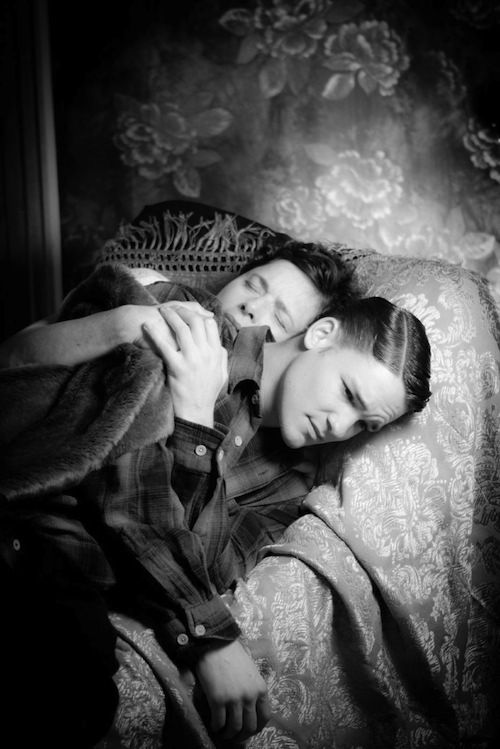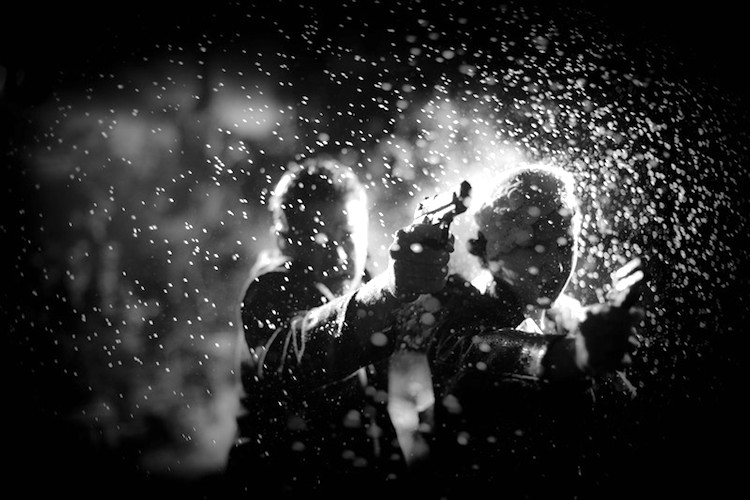By Joe Bendel. It was a dark and stormy life. Just as the Pick family was haunted by their psychological torments in life, so are they still in death. Yet, their gangster father Ulysses Pick has returned to his haunted home for a sort of exorcism/intervention – and perhaps a spot of redecorating – in Guy Maddin’s Maddinesque Keyhole (trailer here), which opens this Friday in New York.
The police have the house surrounded, but the Pick Gang shoots their way in anyway, much to the consternation of his henchmen. Their griping means little to Pick, arriving through the backdoor with Denny, a waterlogged psychic slung over his shoulder. She is to help him reach some sort of spiritual rapprochement with the ghost of his wife Hyacinth haunting the floor above with the spirit of her naked father chained to her bedpost.
To reach his wife Pick will have to pass through door after door of their Escher house, accompanied by Denny, while dragging the man his gang just kidnapped, lashed securely to a chair. That would be Pick’s youngest son Manners, but for some strange reason he does not recognize him as such, despite the efforts his increasingly restive men made to get him. Then things get a little surreal.

Keyhole is definitely a Guy Maddin film, which is cool, because the Canadian auteur might be the single most distinctive visual stylist working in film today. True, events in Keyhole do not always make strict logical sense, but it is consistently rewarding just watching Maddin subvert and reinvent Old Dark House movie motifs. Even Manners Pick’s name pays homage to David Manners, the blue-blooded Canadian actor remembered as the ineffectual protagonist of Universal’s original Dracula and The Mummy features.
Considering how important the look and atmosphere is to Keyhole’s overall viewing experience, Maddin’s’ gets some critical assists from his crew. Benjamin Kasulke’s shimmering black-and-white cinematography is quite Maddin-worthy, but also true to the wonderful 1930’s and 1940’s bump-in-the-night films that inspired Keyhole. Production designer Ricardo Alms and set decorator Matt Holm have also created a richly detailed and thoroughly spooky environment, generously appointed with Freudian knickknacks throughout.
Jason Patric plays the Homeric gangster with perfectly steely resolve and world-weary resignation. However, it is a bit difficult to see him and Isabella Rossellini as a couple, though their awkward chemistry is rather appropriate given the dramatic context. Frankly, by its nature Keyhole is not an actor’s film per se, largely using its supporting cast more as props than as flesh and blood characters. Yet Brooke Palsson somehow conveys something human and vulnerable about Denny, before Maddin completely pulls the rug out from under everyone. To the joy of genre fans everywhere, Lars Von Trier and Uwe Boll regular Udo Kier is also on-hand, actually taking a straight and effective dramatic turn as the grieving Dr. Lemke.
If you like Maddin’s work (and you should), than you will like Keyhole. However, it is probably not the best starter film those previous unfamiliar with his bizarre quasi-genre fabulations (check out the often brilliant My Winnipeg first). Maddin is one of the few filmmakers with a genuinely unique vision and there are an awful lot of his visions in Keyhole. There is plenty of storyline as well, that is mostly linear and easy to follow, even if it does not completely fit together. Still, audiences should not sweat the details here. Keyhole is enthusiastically recommended to anyone looking to take a fever-trip on a cold winter’s night. A film for a real movie screen, Keyhole opens this Friday (4/6) in New York at the IFC Center.
LFM GRADE: A-
Posted on April 6th, 2012 at 2:32pm.
